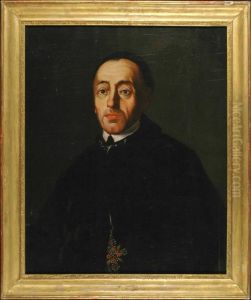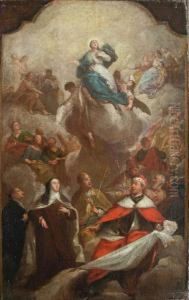Jan Petr Molitor Paintings
Jan Petr Molitor, a notable figure in the realm of art history, was born in 1587, during a period that was on the cusp of the Renaissance and Baroque eras, providing a fertile ground for artistic innovation and exploration. His life and work were deeply embedded in the cultural and historical context of early 17th-century Europe, a time marked by significant social, political, and religious upheaval. Molitor's contributions to the art world were primarily in the domain of painting, where he distinguished himself with a style that blended the detailed narrative focus of the Renaissance with the emerging dynamism and emotional expressiveness of the Baroque.
Molitor's artistic journey commenced in his homeland, where he was initially trained in the techniques and principles that defined late Renaissance art. His early works are noted for their adherence to the balanced compositions and idealized forms characteristic of the period. However, as his career progressed, Molitor began to infuse his creations with the more dramatic elements and vigorous movements that heralded the Baroque sensibility. This evolution in his style is reflective of the broader transition in European art as artists started to embrace more theatrical compositions and sought to evoke deeper emotional responses from their audience.
Throughout his career, Molitor showed a keen interest in religious themes, which were prevalent in the art of his time due to the Counter-Reformation's emphasis on using art as a means of religious education and inspiration. His paintings often depicted biblical scenes and saints, rendered with a vividness and intensity that aimed at inspiring devotion and reflection in the viewer. Moreover, Molitor's work is noted for its meticulous attention to detail and his ability to convey texture and light, adding a layer of realism to his otherwise idealized figures.
Despite his contributions to the development of Baroque painting, Jan Petr Molitor remains a relatively obscure figure in art history, overshadowed by his more famous contemporaries. Nevertheless, his works provide valuable insights into the transitional period between the Renaissance and Baroque eras, illustrating the shifts in artistic priorities and techniques that defined this pivotal moment in European art. Molitor's death in 1639 marked the end of a career that, while not widely celebrated, played a part in the rich tapestry of 17th-century European art, contributing to the evolution of visual storytelling and the exploration of human emotion through painting.

